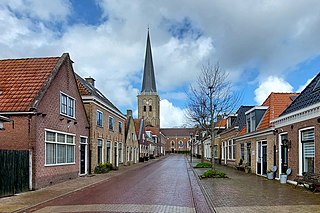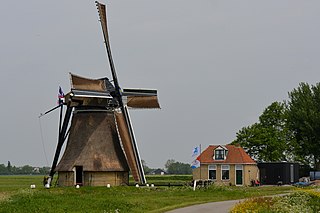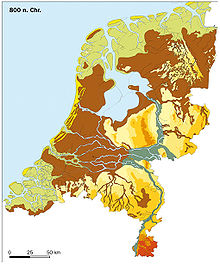
Dantumadiel is a municipality in the province of Friesland in the Netherlands. Dantumadiel is a rural municipality characterized by economic activity and agriculture.

Vlieland is a municipality and island in the northern Netherlands. The municipality of Vlieland is the second most sparsely populated municipality in the Netherlands, after Schiermonnikoog.

Harlingen is a municipality and a city in the northern Netherlands, in the province of Friesland.

Eanjum is a village in the Dutch province of Friesland. It is located in the municipality Noardeast-Fryslân and had, as of January 2017, a population of 1136.

Langweer is a village in Friesland in the municipality De Fryske Marren. The town was established in 1256, and has a population of 1,105 . Langweer has a rich trading history, and it is located at a small lake (Langweerderwielen).

Coert or Court Lambertus van Beyma, son of Julius Matthijs van Beyma and Fokel Helena van Burmania, was a public notary and auctioneer, delegate and representative of the Frisian States, and the radical leader of the Frisian patriots. He was the initiator of a Frisian coup and spent seven years in exile in north-western France. On his return to the Netherlands in 1795, he became a delegate to the National Assembly of the newly established Batavian Republic.

Peperga is a small village in Weststellingwerf in the province Friesland of the Netherlands. As of 2017, it has a population of 85 people, living in approximately 35 houses, and is characterized by detached houses, several businesses and a church. Peperga is located on the A32 between Wolvega and Steenwijk, with public transportation offering a service to the nearby villages of Steggerda and De Blesse.

Arum is a village in the Súdwest-Fryslân municipality in the Dutch province of Friesland. It is about 5 km southeast of the city of Harlingen.

Ferwert is a village in Noardeast-Fryslân in the province of Friesland, the Netherlands. It had a population of around 1787 in January 2017. Before 2019, the village was part of the Ferwerderadiel municipality.

Tzum is a village in Waadhoeke municipality in the province of Friesland, the Netherlands. It had a population of around 1,164 in January 2014. Tzum is known for its 72 metre tall church tower.

Rinsumageast is a village in the Dantumadiel municipality of Friesland, the Netherlands. It had a population of around 965 in 2017.

Magnus Forteman (809) was the legendary first potestaat and commander of Frisia which is now part of Germany and the Netherlands. His existence is based on a saga's writings.
A grietenij was a municipal district, a forerunner to the gemeente or municipality in Frisia, particularly in Friesland, and also in the city Groningen which are now a part of the Netherlands. After the Saxon occupation, from about 1498 until 1851, there were a total of 30 grietenijen in Friesland and 11 cities.

The Frisian Kingdom, also known as Magna Frisia, is a modern name for the post-Roman Frisian realm in Western Europe in the period when it was at its largest (650–734). This dominion was ruled by kings and emerged in the mid-7th century and probably ended with the Battle of the Boarn in 734 when the Frisians were defeated by the Frankish Empire. It lay mainly in what is now the Netherlands and – according to some 19th century authors – extended from the Zwin near Bruges in Belgium to the Weser in Germany. The center of power was the city of Utrecht.

Jacobus Deketh was a captain in the Frisian Admiralty, one of the five admiralties of the Dutch Republic. In 1744 at the age of 18, Deketh joined the Admiralty of Amsterdam. He became a lieutenant and later extraordinary captain and sailed to the Dutch East Indies. In 1758, Deketh continued his career in the Frisian Admiralty. He became captain of a ship, Edam. He was appointed full captain of the Frisian Admiralty in 1760.

De Fryske Marren is a municipality of Friesland in the northern Netherlands. It was established 1 January 2014 and consists of the former municipalities of Gaasterlân-Sleat, Lemsterland, Skarsterlân and parts of Boarnsterhim, all four of which were dissolved on the same day. The municipality is located in the province of Friesland, in the north of the Netherlands, and has a population of 51,778 and a combined area of 559.93 km2 (216.19 sq mi).
Biniaterp, originally Berdingadorp was a village in Friesland Netherlands, to the south of Harlingen. Much of it was lost due to flooding caused by sea encroachment. Villages Medumwart, Dikesherna and parts of the Gerbranda estate lands were also lost due to sea encroachment. The church at Berdingadorp was merged with the church at Almenum. In 1471 the place as known as Bengeterp, and in 1546 as Benyeterp

De Puollen is a hamlet in the Dutch municipality of Waadhoeke in the province of Friesland. It is located to the south of Deinum and on the east side of Dronryp, of which it is a part administratively. The Puolfeart flows through the hamlet and its surrounding polder. This canal forms the heart of the hamlet, which consists of scattered residences on the Puoldyk.
Dijkshoek is a hamlet in the Dutch municipality of Waadhoeke in the province of Friesland. It is located near the Wadden Sea north of Tzummarum and northwest of Firdgum, of which it is a part administratively. The settlement of the hamlet is located on the Camstrawei, consisting of mainly farms on the edge of the Hornestreek.

Kie is a hamlet in the Dutch municipality of Waadhoeke in the province of Friesland. It is located northwest of Hitzum, southeast of Herbaijum and just southwest of Franeker, of which it is a part administratively. The settlement of the hamlet is located on a road of the same name. The Van Harinxma Canal, formerly called the Harlingertrekvaart, flows north of Kie.



















